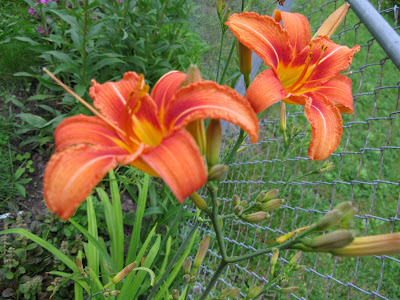Day Lily

Here we are on the last day of June. We recently made the transition from Spring to Summer and Mother Nature continues to bless us with her beautiful flowers.
Just two days ago the Day Lillies came into bloom, right on time. This year the lillies are at least 6 - 7 feet tall. When I tried to take a photo I found it difficult to take a photo from above :-)
Daylily is the common name of the species Hemerocallis
The name Hemerocallis comes from the Greek words (hēmera) "day" and (kalos) "beautiful". These perennial flowers of most species open at sunrise and wither at sunset, possibly replaced by another one on the same stem the next day.
The name Hemerocallis comes from the Greek words (hēmera) "day" and (kalos) "beautiful". These perennial flowers of most species open at sunrise and wither at sunset, possibly replaced by another one on the same stem the next day.

Originally native from Europe to China, Korea, and Japan, they are popular worldwide. There are over 60,000 registered cultivars.
Daylilies occur as a clump including leaves, the crown, and the roots. Once established, it is difficult to remove runner daylilies from the yard. I originally had them planted in various locations around the garden but they multiply so quickly that I am currently transplanting them to their very own border along the entire length of the house where they can do whatever they will without choking out other perennials around them. They require no special attention and are glorious when they are in full bloom.
Daylilies can be grown in USDA plant hardiness zones 1 through 11, making them some of the most adaptable landscape plants.

Sweet William (Dianthus barbatus)
Name from Greek dios, divine, and anthos, flower, referring to its fragrance

Origin from Europe - introduced into Britain in 1573. Blooms late spring-summer and loves full sun. Propagation by seed. Once established will replace itself with self-sown plants.

Clematis (Nelly Moser)
Clematis ‘Nelly Moser’ is an heirloom hybrid gardened since 1897, & developed from Clematis lanuginosa , a Chinese species. The breeder was Marcel Moser of Versailles, France. He took his first bar-flowered hybrid, named for himself, & crossed 'Marcel Moser' with 'Belisaire,' and arrived at the name 'Nelly Moser.'
This perennial is easy to grow. If you open your hand as wide as you can stretch your fingers, you'll have before you the size of the flowers on a 'Nelly Moser' clematis. This perennial blooms from May to late June, with a second, less profuse bloom in mid-August.( However, in colder climates this cold-hardy vine won't necessarily have the second bloom period.)

These photos show the Clematis at the end of June. the petals have fallen and
this beautiful seeds remains.
It thrives in a sunny spot but will still bear colorful flowers and keep their delicate color longer in the shade. When planted in full sun, the flower color fades quickly. The light mauve-pink petals have deep rose-pink central bars.
Prune only if needed, as it blooms on the previous year's canes.
Propagation: Root softwood cuttings in spring, semi-ripe cuttings in early summer.

When it goes to silvery seed, the tufts are nearly as attractive as the flowers as
you can see in these photos
Pentstemon - (Beard -Tongue)

This wonderfully ornamental flower has about 250 species.
Related to the foxglove - many have fringed 'beards' - hence the common name.
It it loves the sun and well drained soil - is about 2 feet high and is beautiful.
It has been blooming for a month now.
Thrives in zones 4 - 10.
photos by peacesojourner


No comments:
Post a Comment